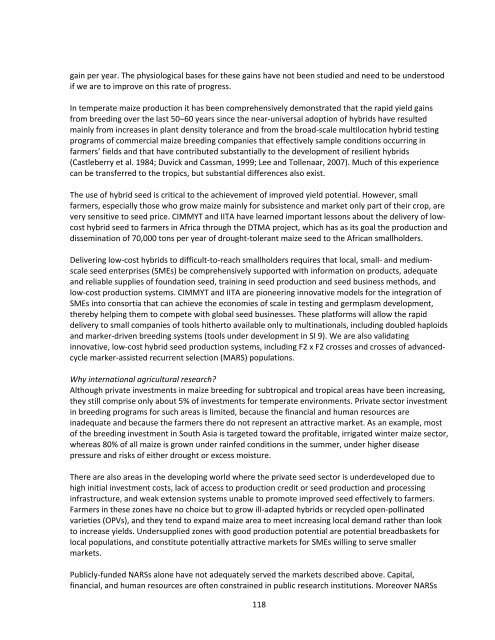Download - Maize
Download - Maize
Download - Maize
You also want an ePaper? Increase the reach of your titles
YUMPU automatically turns print PDFs into web optimized ePapers that Google loves.
gain per year. The physiological bases for these gains have not been studied and need to be understood<br />
if we are to improve on this rate of progress.<br />
In temperate maize production it has been comprehensively demonstrated that the rapid yield gains<br />
from breeding over the last 50–60 years since the near‐universal adoption of hybrids have resulted<br />
mainly from increases in plant density tolerance and from the broad‐scale multilocation hybrid testing<br />
programs of commercial maize breeding companies that effectively sample conditions occurring in<br />
farmers’ fields and that have contributed substantially to the development of resilient hybrids<br />
(Castleberry et al. 1984; Duvick and Cassman, 1999; Lee and Tollenaar, 2007). Much of this experience<br />
can be transferred to the tropics, but substantial differences also exist.<br />
The use of hybrid seed is critical to the achievement of improved yield potential. However, small<br />
farmers, especially those who grow maize mainly for subsistence and market only part of their crop, are<br />
very sensitive to seed price. CIMMYT and IITA have learned important lessons about the delivery of lowcost<br />
hybrid seed to farmers in Africa through the DTMA project, which has as its goal the production and<br />
dissemination of 70,000 tons per year of drought‐tolerant maize seed to the African smallholders.<br />
Delivering low‐cost hybrids to difficult‐to‐reach smallholders requires that local, small‐ and mediumscale<br />
seed enterprises (SMEs) be comprehensively supported with information on products, adequate<br />
and reliable supplies of foundation seed, training in seed production and seed business methods, and<br />
low‐cost production systems. CIMMYT and IITA are pioneering innovative models for the integration of<br />
SMEs into consortia that can achieve the economies of scale in testing and germplasm development,<br />
thereby helping them to compete with global seed businesses. These platforms will allow the rapid<br />
delivery to small companies of tools hitherto available only to multinationals, including doubled haploids<br />
and marker‐driven breeding systems (tools under development in SI 9). We are also validating<br />
innovative, low‐cost hybrid seed production systems, including F2 x F2 crosses and crosses of advancedcycle<br />
marker‐assisted recurrent selection (MARS) populations.<br />
Why international agricultural research?<br />
Although private investments in maize breeding for subtropical and tropical areas have been increasing,<br />
they still comprise only about 5% of investments for temperate environments. Private sector investment<br />
in breeding programs for such areas is limited, because the financial and human resources are<br />
inadequate and because the farmers there do not represent an attractive market. As an example, most<br />
of the breeding investment in South Asia is targeted toward the profitable, irrigated winter maize sector,<br />
whereas 80% of all maize is grown under rainfed conditions in the summer, under higher disease<br />
pressure and risks of either drought or excess moisture.<br />
There are also areas in the developing world where the private seed sector is underdeveloped due to<br />
high initial investment costs, lack of access to production credit or seed production and processing<br />
infrastructure, and weak extension systems unable to promote improved seed effectively to farmers.<br />
Farmers in these zones have no choice but to grow ill‐adapted hybrids or recycled open‐pollinated<br />
varieties (OPVs), and they tend to expand maize area to meet increasing local demand rather than look<br />
to increase yields. Undersupplied zones with good production potential are potential breadbaskets for<br />
local populations, and constitute potentially attractive markets for SMEs willing to serve smaller<br />
markets.<br />
Publicly‐funded NARSs alone have not adequately served the markets described above. Capital,<br />
financial, and human resources are often constrained in public research institutions. Moreover NARSs<br />
118

















